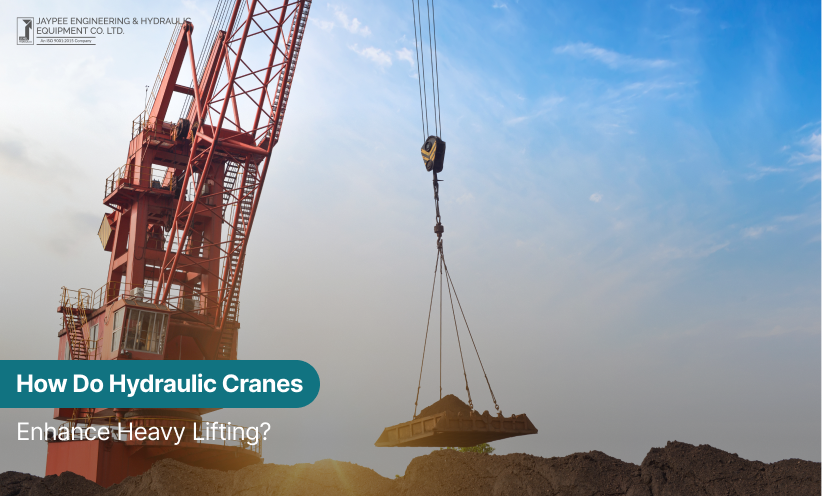When it comes to heavy lifting, hydraulic cranes play a crucial role in various industries. These powerful machines leverage the principles of hydraulics to provide superior lifting capacity, stability, and efficiency. This article will delve into the mechanics of hydraulic cranes, their components, lifting capacity, safety features, advantages, maintenance, and future trends in the industry.
Understanding the Mechanics of Hydraulic Cranes
Hydraulic cranes operate based on the principles of hydraulic systems. These systems utilize the incompressibility of fluids, typically oil, to transmit force and generate motion. By applying Pascal’s law, which states that pressure exerted on a fluid is transmitted equally in all directions, hydraulic cranes can generate immense lifting power through the controlled flow of fluid.
Hydraulic cranes are essential in various industries such as construction, shipping, and manufacturing. Their ability to lift and move heavy loads with precision and efficiency makes them indispensable in modern-day operations. Understanding the mechanics of hydraulic cranes is crucial for ensuring their safe and effective use in diverse work environments.
Basic Principles of Hydraulic Systems
A hydraulic system consists of four main components: a hydraulic fluid, a reservoir, a hydraulic pump, and a hydraulic cylinder. The hydraulic pump draws the fluid from the reservoir and forces it into the hydraulic cylinder, which contains a piston. As the fluid is pushed into the cylinder, it moves the piston, creating a linear force. This force can then be used to lift heavy loads or perform other tasks.
The efficiency of hydraulic systems lies in their ability to multiply force through the use of different sized pistons. By varying the surface area of the pistons within the system, hydraulic cranes can achieve significant mechanical advantage, allowing them to lift objects many times heavier than the force applied. This principle of force multiplication is a key factor in the exceptional lifting capabilities of hydraulic cranes.
Components of a Hydraulic Crane
A hydraulic crane comprises several key components, including the base, mast, boom, jib, and counterweights. The base provides stability and houses the hydraulic system. The mast provides vertical support, while the boom extends horizontally to reach the desired lifting location. The jib, an optional attachment, offers additional reach and flexibility. Counterweights are strategically placed to stabilize the crane during operation.
Modern hydraulic cranes are equipped with advanced features such as telescopic booms, computerized controls, and safety sensors. These technological advancements enhance the precision, safety, and efficiency of hydraulic crane operations. The integration of telematics and remote monitoring capabilities allows for real-time tracking of crane performance and maintenance requirements, ensuring optimal functioning and minimizing downtime.
The Role of Hydraulic Cranes in Heavy Lifting
Hydraulic cranes are specifically designed to handle heavy lifting tasks efficiently and safely. Their lifting capacity and stability features make them crucial assets in industries such as construction, manufacturing, and logistics.
These versatile machines are not only known for their strength but also for their adaptability to various working conditions. Whether it’s lifting materials on a construction site, loading heavy cargo onto ships, or assisting in disaster recovery efforts, hydraulic cranes prove to be indispensable tools in getting the job done.
Lifting Capacity of Hydraulic Cranes
One of the primary advantages of hydraulic cranes is their impressive lifting capacity. Depending on the model and configuration, these cranes can lift loads ranging from a few tons to several hundred tons. The hydraulic system’s ability to exert immense force allows these cranes to handle even the most demanding lifting requirements.
Furthermore, the precision and control offered by hydraulic cranes ensure that heavy loads can be lifted and maneuvered with accuracy, minimizing the risk of damage to the load or surrounding structures. This level of control is essential when working in tight spaces or navigating complex lifting scenarios.
Stability and Safety Features
In addition to their lifting capacity, hydraulic cranes offer exceptional stability and safety features. Stabilizer legs extend from the base to ensure a secure foundation during operation. Hydraulic outriggers further enhance stability by providing additional support. Safety measures such as load moment indicators and boom angle sensors help prevent accidents and ensure safe working conditions.
Moreover, advancements in technology have led to the integration of features like anti-collision systems and remote monitoring capabilities in modern hydraulic cranes. These innovations not only enhance operational efficiency but also contribute to a safer working environment by reducing the risk of collisions and providing real-time data on crane performance.
Advantages of Using Hydraulic Cranes for Heavy Lifting
Hydraulic cranes come with several advantages that contribute to their popularity in heavy lifting operations.
Efficiency and Speed
Hydraulic cranes offer efficient and rapid lifting capabilities, increasing productivity on job sites. The precise control over fluid flow allows for smooth and accurate movements, minimizing downtime and optimizing workflow.
Versatility in Various Work Environments
Hydraulic cranes are versatile machines that can adapt to different work environments. Their maneuverability, combined with a range of attachments and accessories, enables them to tackle various tasks, including lifting, loading, and even precise positioning.
Moreover, the advanced technology integrated into hydraulic cranes allows for remote operation in some models. This feature enhances safety by enabling operators to control the crane from a distance, reducing the risks associated with being in close proximity to heavy loads.
Cost-Effectiveness and Maintenance
Another significant advantage of hydraulic cranes is their cost-effectiveness in the long run. While the initial investment may be higher compared to other types of cranes, hydraulic cranes are known for their durability and reliability, requiring minimal maintenance over their lifespan.
Maintenance and Operation of Hydraulic Cranes
To ensure the longevity and reliability of hydraulic cranes, proper maintenance and operation are pivotal.
Hydraulic cranes are a crucial piece of equipment in various industries, including construction, shipping, and material handling. These powerful machines rely on hydraulic systems to lift and move heavy loads with precision and efficiency.
Regular Inspection and Maintenance
Regular inspections and maintenance routines are crucial to identify potential issues and prevent breakdowns. Hydraulic fluid levels, hydraulic cylinder seals, and mechanical components should be routinely checked and serviced according to the manufacturer’s guidelines.
Additionally, keeping the hydraulic system clean and free of debris is essential to prevent contamination and ensure optimal performance. Regularly inspecting hoses and fittings for wear and tear can help prevent leaks and maintain the integrity of the system.
Training for Crane Operators
Well-trained and skilled crane operators are essential for safe and efficient crane operation. Operators must undergo comprehensive training, including understanding hydraulic systems, load dynamics, and safety protocols.
Furthermore, operators should be familiar with the specific capabilities and limitations of the crane they are operating. Proper communication between the operator and ground personnel is also crucial to ensure smooth and safe lifting operations.
Future Trends in Hydraulic Crane Technology
The hydraulic crane industry is continuously evolving to meet the demands of modern construction and heavy lifting requirements.
As technology progresses, the future of hydraulic cranes holds exciting possibilities. One area of innovation lies in the development of smart hydraulic systems that can self-monitor and adjust parameters in real-time, optimizing performance and reducing maintenance needs. These systems may incorporate artificial intelligence algorithms to analyze data and predict potential issues before they occur, ensuring maximum uptime and operational efficiency.
Innovations in Hydraulic Systems
Ongoing advancements in hydraulic system technology aim to enhance efficiency, durability, and precision. Innovations such as improved fluid filtration, energy-efficient pumps, and advanced control systems promise increased performance and reduced environmental impact.
Furthermore, researchers are exploring the integration of Internet of Things (IoT) technology into hydraulic cranes, enabling remote monitoring and diagnostics. This connectivity allows operators to track crane performance, receive real-time alerts, and schedule predictive maintenance, ultimately improving safety and productivity on job sites.
Environmental Impact and Sustainability
In response to growing environmental concerns, hydraulic crane manufacturers are focusing on enhancing sustainability. This includes the development of eco-friendly fluids, energy recovery systems, and reducing overall energy consumption through efficient hydraulic designs.
Moreover, the shift towards electrification in the construction industry is influencing hydraulic crane design. Hybrid and electric-powered cranes are becoming more prevalent, offering reduced emissions and quieter operation without compromising performance. These eco-conscious solutions align with global efforts to reduce carbon footprints and promote greener construction practices.
Hydraulic cranes play a vital role in the world of heavy lifting, offering unparalleled lifting capacity, stability, and efficiency. With ongoing advancements and a commitment to safety and sustainability, hydraulic cranes will continue to enhance heavy lifting operations for years to come.


